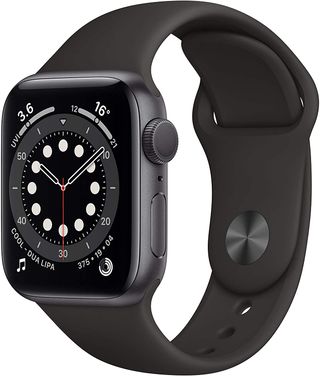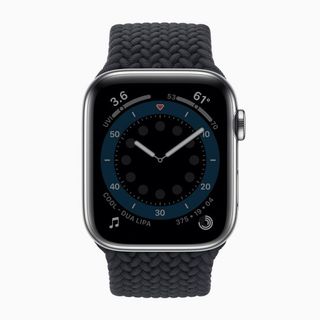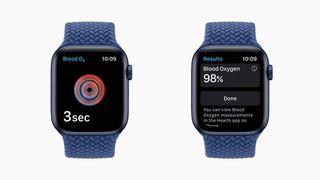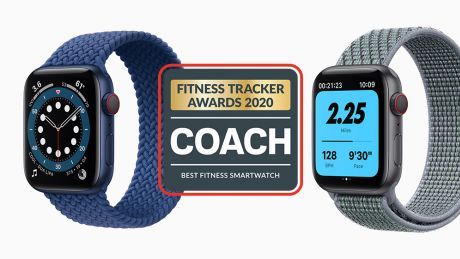Our Verdict
Although it has been superseded by the Series 7, the Apple Watch Series 6 is still one of the best smartwatches around if you can get hold of it.
For
- Impressive app store
- Engaging activity tracking
- Attractive design
Against
- One-day battery life
- Smaller screen than Series 7
- Weak sleep tracking
You can trust Coach
The key addition to the Apple Watch Series 5 was the always-on screen, which significantly improved the quality of experience when using the watch, especially when tracking sports. The upgrades to the Series 6 are low-key in comparison, but it is brighter, a little faster, slightly cheaper and can now measure your blood oxygen saturation. All useful updates that help the Apple Watch retain its crown as the best smartwatch available.

Tracking Activity With The Apple Watch Series 6
I don’t find the everyday activity tracking goals on most devices especially compelling. I run almost everyday and my fitness goals lie in bringing my times down rather than notching 10,000 steps each day. However, the Apple Watch’s ring system draws me in every time I use it. I have to fill those rings, and if needs be I will walk up and down stairs at 10pm to make sure I do.
There are three rings to fill. The red one is an active calorie target, set at 500 as standard, but if you hit the target every day for a week the watch will suggest that you increase it. The green ring is active minutes, with an adjustable target set to 30 a day as standard. The blue ring is active hours – you have to be active at some point every hour for 12 hours in total to fill it (you can reduce this target, but not increase it). You’ll be alerted at ten to the hour if you’re going to miss this, which works well as an inactivity alert.
There’s nothing hugely groundbreaking about this system, but it’s effective for monitoring and stimulating your general activity. For anyone who lives a mostly sedentary life, the active calories and minutes goals should help to get you moving each day, while the already active will still find motivation in the active hours goal. It’s not a great idea to do one big sports session each day then sit for the rest of it, something I’ve often found myself guilty of during the COVID-19 pandemic when I’m mostly at home.
Filling your rings might not be enough to help you lose weight or push your fitness to greater heights if you’re already very sporty, but it will encourage you to move each and every day.

Running With The Apple Watch Series 6
Casual runners will get everything they need from the native Workout app on the Apple Watch, which during a run displays the key stats like time, distance, pace and cadence (steps per minute). The always-on screen is brighter on the Series 6 so you can see those stats easily without turning your wrist to properly wake the device, even when outside.
The accuracy is impressive too. The heart rate monitor is excellent and one of the best I’ve come across in a watch. It’s not infallible, but I like that instead of displaying obviously incorrect readings, it stops showing your heart rate when it can’t get a fix on it, then comes back when it does. Compared with readings from a chest strap during runs, the Apple Watch was generally within a couple of beats, and even on interval runs it would rise and fall pretty closely in line with the strap, lagging less than other watches. It’s still not as accurate as a chest strap, mind, and once on a long run it couldn’t find my heart rate for about an hour.
Most importantly, Apple has finally sorted the GPS accuracy on the watch. I found that all the past editions of the Apple Watch “smoothed” routes, perhaps to save battery by taking GPS readings less frequently, which often meant cutting corners and shortening the distance recorded. I’ve not found this to be the case with the Series 6, which has matched up pretty well to my reliable Garmin watch on most of my runs, though it did struggle on a track session, cutting one or two laps well short. Outside of the track the only difference came in the first kilometre, perhaps because the Apple Watch has no indicator of whether it has a GPS fix – you just start your run and go.
Another notable improvement is that you can export your runs and other activities recorded in the native Workout app to Strava without having to use a third-party app. This took way too long to happen, but I’m glad it has.
All of the above makes the Apple Watch a solid option for casual runners, but as a very committed runner it falls short of what I’d need. That starts with basics like not having standard stats like lap pace and distance available. The rolling pace on offer is a fairly pointless stat in comparison.

The lack of a physical lap button is also a pain. You can double-tap the screen, but a touchscreen is never as reliably responsive as a button, especially if you’re sweaty or it’s raining. You also can’t set up structured workouts, even simple interval ones, and have the watch guide you through them.
In the Apple Watch’s defence there are apps that offer these features, but none can use the always-on screen, which means I’d rather use the native app so I can see my stats more easily.
As such, I wouldn’t use the Apple Watch Series 6 as my running watch and I think any keen runner would get annoyed with it – unless they were happy without an always-on screen, in which case an app like iSmoothRun will all but turn the watch into a bona fide running watch at a stroke.
Working Out With The Apple Watch Series 6
There is no shortage of sports modes in the native Workout app, though in general all you’re really getting is time, heart rate and calories burned. The key exceptions are running, cycling and swimming, which use the GPS for stats like pace and speed, or lengths, and swimmers will also get automatic stroke recognition in the breakdown of their session.
Again, the App Store is laden with apps to improve the training experience. There are hundreds of guided workout apps for every kind of sport, whether you want strength sessions, yoga, or guided runs and swims.
You can get guided workouts on many sports watches now, and some Garmin and Polar devices will recommend workouts based on your fitness and recent training load, although nothing else gets close to what’s available on the App Store. But once more, these apps can’t use the always-on screen so you’ll have to turn your wrist to activate the screen and see the instructions. Not always easy during strength and yoga sessions.
The Apple Watch Series 6’s Heath Features

The marquee new feature on the Apple Watch Series 6 is an SpO2 sensor that can measure your blood oxygen saturation. It’s a sensor that has been on Garmin sports watches, among others, for some time and to be honest it’s rarely been much use unless you’re at altitude where there’s a lack of oxygen.
However, in 2020 blood oxygen saturation has become more relevant owing to the COVID-19 pandemic. If you’re experiencing symptoms doctors will use a finger SpO2 monitor to determine how serious your condition could be and whether you need to go to hospital. (No-one should be making those decisions based on a smartwatch’s readings of course, and nor does Apple advise you to.)
The test is done by opening up the Blood O2 app and clicking start. You then get a nice animation during the 15 seconds it takes to get a reading. After that, assuming you get a normal reading, you’ll probably forget all about it for a few weeks, as I always have done with SpO2 sensors on other watches.
Like the past two Apple Watches, the Series 6 can take a 30-second ECG measurement using Apple’s dedicated app. This can detect atrial fibrillation – an irregular heartbeat. The watch can be set to check periodically whether your heart rate is irregular, and it will notify you when your heart rate is abnormally low or high. If you’re regularly getting alerts, it’s worth seeing a doctor.
A new feature with the latest watchOS update is a handwashing timer that you can set to kick in automatically when the watch detects that you are washing your hands (or the dishes, in my experience). This will count down from 20 seconds to make sure you’re doing a proper job, and has shamed me back to the sink on a few occasions.
The Series 6 also has a noise monitor to alert you to exposure to noise levels of over 90 decibels for an extended period. There’s also menstrual health tracking features which will predict your next period and fertility window.
Sleep Tracking With The Apple Watch Series 6
After years of ignoring sleep tracking, Apple introduced it via a software update this autumn. It wasn’t worth the wait. All you get is sleep duration with a graph that marks disturbances. You can also see a trend in how much you’ve slept in the past seven days compared with the seven before that. That’s it.
This is miles behind the depth of detail you get from other brands like Fitbit, Huawei, Polar and Withings. As of now, the sleep tracking on the Apple Watch isn’t really worth the hassle it creates by forcing you to find more time to charge it each day. Speaking of which…
Battery Life On The Apple Watch Series 6
The Apple Watch will easily last you a full day and night of use. I’d wear it until 8pm, charge it, then put it back on just before I went to sleep at 10-11pm. Usually I’d have 40% or more battery left, and even on days where I had logged a long outdoor run I’d have over 30% left.
However, this routine is not as convenient as charging it overnight, as I did when the Apple Watch didn’t have sleep tracking. Now, if I’m out in the evening, I have to remember to charge the watch earlier in the day to make sure it lasts the night. It only takes an hour to get it to 80%, which helps, but if you’re on the move a lot finding even an hour might prove tricky.
Admittedly, during the pandemic I’m out a lot less, but when the world returns to normal I’d revert to charging the watch each night and forgo the basic sleep tracking.
The Apple Watch Series 6’s Smartwatch Features

The Apple Watch is the most useful wearable I’ve ever worn. If you opt for the version with cellular connectivity then being away from your phone and staying in touch with the world becomes possible. It’s especially useful for those who like to run and cycle without a phone but want to be contactable in case of an emergency.
Apple Pay is very handy, especially compared with the limited NFC payment options on Fitbit and Garmin, which have only managed to partner with one high street UK bank. Apple Wallet is also useful for storing plane and train tickets, and supermarket loyalty cards.
However, the way music and podcasts are managed on the watch remains a source of frustration. The Apple Watch automatically syncs select audio from your phone when charging and with music you can select what to transfer, but with podcasts you can’t select episodes. It either takes from the Up Next section or you select shows you want and it will attempt to add the most recent three episodes. Attempt is the operative word, since it’s not reliable. It seems a very basic thing to fix, but it’s been an issue since Apple added podcasts to the watch, so I’m not holding my breath.

For music streaming, unsurprisingly Apple Music users will get the most from the watch. Spotify users can only control the app on their phone using the Apple Watch, which is a shame because on Garmin and Samsung wearables you can sync Spotify playlists across to listen to offline.
Apple Watch Series 6 Design
It’s a very smart bit of kit, and there are endless ways to customise it with either the material used for the watch itself or the straps available. With the Series 6, Apple has introduced red and blue watches, as well as silicone and braided solo loops that you can slip onto your wrist, rather than having to fasten them.
Is The Apple Watch 6 Worth It?
If you’re an iPhone user the Apple Watch Series 6 is clearly the best smartwatch you can get. If you’re an Android user then it offers you absolutely nothing at all, so do get something else.
Apple has muddied the waters for iPhone users a little by releasing the Apple Watch SE (from £269), sitting between the Series 3 and the Series 6 in terms of price and features.
The SE and Series 3 (from £199) doesn’t have an always-on screen option, and the Series 3 carries Apple’s older and far less accurate heart rate sensor. Neither of the cheaper watches can perform ECG scans or blood oxygen saturation measurements.
The SE and 3 also suffer from the GPS problems that seem to have been fixed in the Series 6, which will affect runners most of all. I’d say the always-on screen is worth the extra cost alone if you’re going to use the Apple Watch to track sports, but if you’re happy with raise-to-wake, the SE covers the other everyday essentials on the watch.
Outside of smartwatches, the Apple Watch falls short of the sports performance you get from cheaper dedicated watches like Garmin’s Forerunner range. If you’re a keen runner or triathlete, you’ll probably end up frustrated with the limitations of Apple’s native sports tracking. Although there are excellent third-party tracking apps available, you can’t use the always-on screen with these and the battery life is still poor, so I’d recommend getting a sports watch instead.

Nick Harris-Fry is a journalist who has been covering health and fitness since 2015. Nick is an avid runner, covering 70-110km a week, which gives him ample opportunity to test a wide range of running shoes and running gear. He is also the chief tester for fitness trackers and running watches, treadmills and exercise bikes, and workout headphones.

